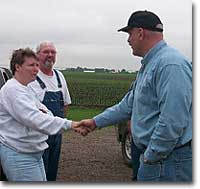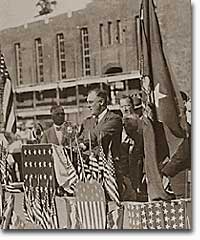
12. State and Local Governments

Large-scale public works projects require federal and state governments to cooperate and compromise, especially when deciding who pays for what. The construction of the Interstate Highway System was a crowning achievement of this sometimes strained partnership.
Governors. Mayors. State Representatives. City Council members. Sheriffs.
Beneath the layer of the national government lies a complex web of state and local officials and institutions. The nation's founders concern over tyranny transcended their separation of power among the three branches of government. Power is also divided by level, with each layer performing its designated responsibility. States and communities would even have the freedom to design their own institutions and create their own offices. This creates a multitude of "laboratories" where government leaders at any level could see which systems were successful and which were problematic.
State Constitutions

This well-built Governor looks like he could be a wrestler. Wait, he was a wrestler: Jesse Ventura of Minnesota broke onto the local and national political scene by becoming the first Reform Party candidate to win the governorship of a state.
The states had constitutions years before the United States Constitution was even written. Since the Declaration of Independence, states have written a total of about 150 constitutions, with several states writing new ones frequently. State constitutions tend to be quite a bit longer than the national one — an average of four times as long — so they also are more specific. As a result, they often are heavily amended and rather easily tossed out, at least in some states. State constitutions determine the structure, role, and financing of state and local levels of government.
State Officials
Each of the 50 states has its own array of public officials, with no two states being exactly alike. But all of them have Governors, legislatures, and courts:
- Governors. In every state the Governor is chosen by popular vote, and most serve four-year terms. More than half of the states put limits on the number of times an individual may be elected called term limits. In most states, several other top officials are elected, including a Lieutenant Governor, a Secretary of State, and an Attorney General. In general, Governors have the authority to issue executive orders, prepare the state budget, make appointments, veto legislation, and to grant pardons to criminals. In states that tend to concentrate powers in the hands of a few, Governors have broader authority and more powers. In other states, power is spread out among many elected officials, or is strongly checked by the legislature.
- State legislatures. Every state has a bicameral, or two house, legislature, except for Nebraska, which has a unicameral body. State legislatures vary in size from 20 to 400, and are not necessarily in proportion to the size of the state's population. For example, New Hampshire has 400 members in its lower house. All states have guidelines for age, residency, and compensation, and most legislatures meet in annual sessions. Just as in the national legislature, many state legislators serve for several terms, creating a large body of professional politicians in the United States.
- State courts. Each state has its own court system, and most have a state Supreme Court. State judges have the final voice in the vast majority of cases in the United States since more come under state rather than federal jurisdiction. Most states have two types of courts — trial courts that handle issues from traffic fines to divorce settlements to murder, and appeals courts that hear cases appealed from lower courts.
Types of Local Governments
Local governments are generally organized into four types:
- Counties. Counties are usually the largest political subdivisions, and their primary function is to administer state laws within their borders. Among other duties, they keep the peace, maintain jails, collect taxes, build and repair roads and bridges, and record deeds, marriages, and deaths. Elected officials called Supervisors or Commissioners usually lead counties.
- Townships. These units of government do not exist in about half the states, and they have different responsibilities in those that have them. A township may simply be another name for a town or city, or it may be a subdivision of a county.
- Special Districts. These units of government have special functions. The best known example is the local school district, but other types are growing in numbers, especially in heavily populated areas where county and city governments may be overloaded with work.
- Municipalities. City, town, or borough governments get their authority to rule only as it is granted by the state. Today about 80% of the American population lives in municipalities, and municipal governments affect the lives of many citizens. Municipalities may have elected mayors, or they may be managed by appointed city managers.

Governorship can often be an opportunity to pursue higher office; several state Governors have gone on to become President. Before he became one of the most notable chief executives of the century, Franklin Roosevelt served as Governor of New York.
The organization of state and local governments varies widely across the United States. They have common specific features, but their organizations differ. Regardless of their design, state and local governments often have a far greater impact on people's lives than the federal government. Marriage, birth, and death certificates. School policies. Driving age and qualifications for licensure. Laws regarding theft, rape, and murder, as well as the primary responsibility of protecting citizens from criminals. These critical issues and many others are not decided by distant Washington authorities, but by state and local officials.






